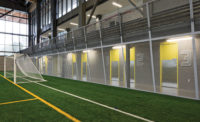Stainless steel woven mesh is architecturally valuable for its strength and versatility, and designers are increasingly incorporating it in ways that ensure both form and function. Two very disparate examples of this trend include the Ford Research & Engineering Center Parking Garages in Dearborn, Michigan, that incorporated Cambridge Architectural’s Huron product, a 100-percent-recyclable T316 stainless steel woven mesh with an elongated triangular pattern and 55 percent open area. This durable design is ideal for façades—particularly parking structures—seeking an “openness” for visibility and ventilation. And for the design of the sleek and stylish retail store Hunke Jewelers and Opticians in Ludwigsburg, Germany, Ippolito Fleitz Group, a Stuttgart-based interior design firm, turned to German fabricator Hasselwander to incorporate a variety of architectural mesh in unexpected ways. They developed a vertical surfacing application for the spacious jewelry section—clad with floor-toceiling decorative wire mesh in brass from Banker’s Wire. The effect is fine and elegant, creating a glittering, ornamental look complementary of the wares on display. The antique brass-plated S-12 wire mesh, fashioned into a flowing curtain, adds texture and subtle movement, providing a soft glint from the reflecting lights and contrast to the neutral tones throughout the rest of the space.
Designers Incorporate Cambridge Architectural’s Stainless Steel Woven Mesh Into Interior Spaces

In the German retail store Hunke, designers incorporated a brass mesh wall feature from Banker’s Wire.
Photo courtesy Zooey Braun

In the German retail store Hunke, designers incorporated a brass mesh wall feature from Banker’s Wire.
Photo courtesy Zooey Braun

Cambridge Architectural’s durable Huron 100-percent-recyclable T316 stainless steel woven mesh is ideal for façades seeking visibility and ventilation.
Photo courtesy Zooey Braun




Post a comment to this article
Report Abusive Comment